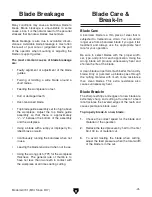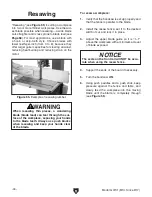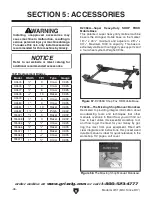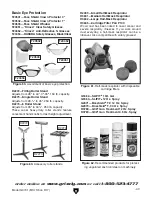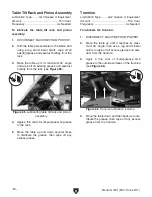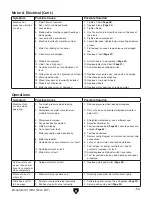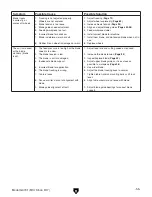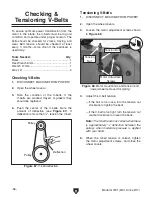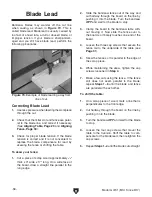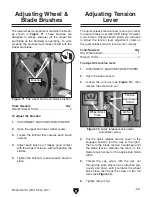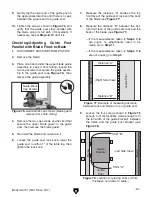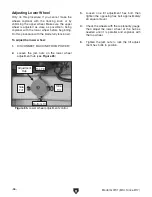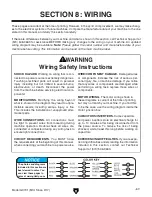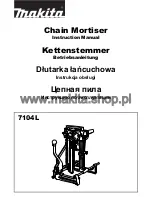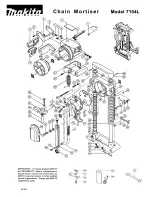
Model G0701 (Mfd. Since 9/17)
-53-
Symptom
Possible Cause
Possible Solution
Machine has
excessive vibration
or noise.
1. V-belt tension incorrect.
2. Bent, dull, or damaged blade.
3. Loose blade.
4. Blade weld contacting support bearing or
blade guides.
5. Loose machine component.
6. Machine incorrectly mounted on floor.
7. Motor fan rubbing on fan cover.
8. V-belt worn or damaged.
9. Wheels not coplanar.
10. V-belt has a high spot.
11. Centrifugal switch out of adjustment; at
fault.
12. Pulley loose or not in alignment; shaft bent.
13. Worn wheel bearing.
14. Wheel tires worn or incorrectly installed.
15. Wheels out of balance.
16. Motor bearings worn or damaged.
1. Tighten V-belt (
Page 56).
2. Replace blade (
Page 42).
3. Tighten blade.
4. Use file or stone to smooth and round the back of
the blade.
5. Tighten loose component.
6. Level/shim base; tighten/adjust mounting hardware
or feet.
7. Fix/replace fan cover; replace loose or damaged
fan.
8. Replace V-belt (
Page 57).
9. Adjust wheels to be coplanar (
Page 64).
10. Replace/adjust the V-belt (
Page 57).
11. Adjust/replace centrifugal switch.
12. Replace worn pulley, key, and shaft, and realign.
13. Check/replace wheel bearing.
14. Replace or re-install wheels.
15. Replace wheels.
16. Replace motor bearings or replace motor.
Motor & Electrical (Cont.)
Symptom
Possible Cause
Possible Solution
Machine stalls
or slows when
operating.
1. Too much pressure when feeding
workpiece.
2. Workpiece too moist or material not
suitable for machine.
3. Workpiece is warped.
4. Fence incorrectly adjusted.
5. V-Belt(s) slipping.
6. Run capacitor at fault.
7. Motor connection wired incorrectly.
8. Motor overheated.
9. Contactor has poor contacts or is at fault.
10. Centrifugal switch at fault.
11. Main motor at fault.
1. Reduce pressure when feeding workpiece.
2. Only cut wood and ensure workpiece moisture is
below 20%.
3. Straighten workpiece or use a different one.
4. Adjust/calibrate fence.
5. Tension/replace belt (
Page 56); ensure pulleys are
aligned (
Page 64).
6. Test/repair/replace.
7. Review wiring diagram on motor cover; correct wire
connections.
8. Let cool, clean motor, and reduce workload.
9. Test all legs for power, test field coil, and fix
contacts or replace if at fault.
10. Adjust/replace centrifugal switch if available.
11. Test for shorted windings, bad bearings and repair
or replace.
Guide post moves
slower than normal,
travel is sporadic, or
stops completely.
1. Guide post motor at fault.
1. Replace guide post motor (
Page 62).
Miter bar binds in
miter slot.
1. Miter slot dirty or gummed up.
1. Carefully clean miter slot with mineral spirits.
Table does not tilt
to 0 degrees.
1. Pointer or scale calibrated incorrectly.
2. Positive stop bolt not set correctly.
1. Calibrate pointer/scale at true 0 degrees (
Page 32).
2. Adjust positive stop bolt (
Page 20).
Operations



